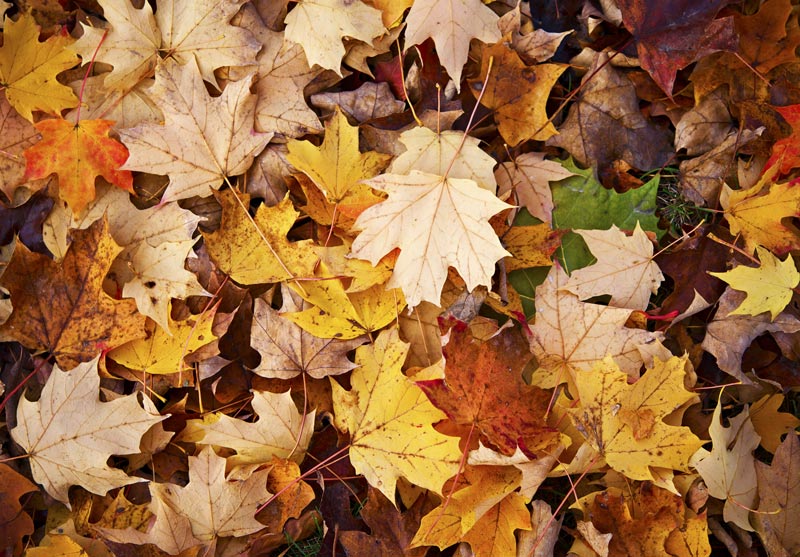
When fall gives you leaves, make mulch. Photo by Welcomia/Freepik
Editor’s note: The following article first appeared in the August 1997 issue of GCM. Because of its timeless insights for turf managers, we’ve dusted it off and are presenting it anew.
Golf course superintendents aren’t alone in dealing with tree leaf disposal. The disposal of yard waste in landfills was eliminated as the Solid Waste Management Act became effective on March 27, 1995. This federal act also made the Clean Air Act of 1970 more stringent by prohibiting the open burning of leaves in municipalities with populations of 7,500 or more. Compost piles are prohibited in many areas. Tree leaf disposal has become an economic problem as well as a laborious one.
In 1988, there were 7,924 landfills in the United States, but by 1994, the number had declined to 3,558 (2). Yard waste was taking up more than 17% of landfill space. The Solid Waste Management Act relieved the burden on our landfills but created a leaf disposal problem in fall. New strategies for handling leaf litter became necessary.
In 1988, fewer than 800 composting facilities were receiving waste. By 1994, 3,202 yard-waste-composting facilities were operating (2). A local Michigan composting center charges $4.60 per cubic yard of leaves. The back of a normal pickup truck holds 3 cubic yards.
In New Jersey, one means of leaf litter disposal has been the direct application of municipal leaf litter to farmland. This was approved as an emergency disposal/utilization strategy (1). As of 1994, 24 states used this practice (2). But there are concerns that heavy metals may be transported to our farmland in this manner. In a thorough 1996 study conducted by J.R. Heckman and D. Kluchinski at Rutgers University, they attributed such heavy metal concentrations to the leaf litter collection process.
The search for a leaf disposal solution
In the fall of 1990, a leaf-mulching study was initiated at the Hancock Turfgrass Research Center at Michigan State University. Treatments were no leaves, 50 pounds (which covers the top of your shoe), or 100 pounds (ankle height) of dry leaves per 1,000 square feet. Treatments were mulched into plots in November of each year with a rotary lawn mower. The predominantly Kentucky bluegrass turf was maintained at a 3-inch cutting height. Nitrogen aids in the breaking down of leaves in the composting process, so two different nitrogen rates (2 and 4 pounds of nitrogen per 1,000 square feet) were included in the study.
In 1991, a second leaf mulch study was initiated to examine the effects different leaf types would have on turfgrass. Oak and maple leaves were mulched into Midnight Kentucky bluegrass plots at 100 pounds of dry leaves per 1,000 square feet. Nitrogen was applied at 4 pounds per 1,000 square feet annually with either a spring or fall emphasis. Spring-emphasis applications were made in April, May, July and August, while fall applications were made in June, July, September and October. A check plot with no nitrogen was included.
Leaf mulch research results
Since the inception of the leaf mulch studies, we’ve seen few visual differences between mulched and non-mulched plots. Turfgrass color and density ratings indicate no negative impact from leaf mulching at the rates applied in this study. Weed counts in 1995 indicated that plots receiving maple leaves had fewer broadleaf weeds and less crabgrass. These data also point out the importance of proper fertility in keeping up turfgrass density to minimize weed infestation. We’ve observed no turfgrass disease differences.
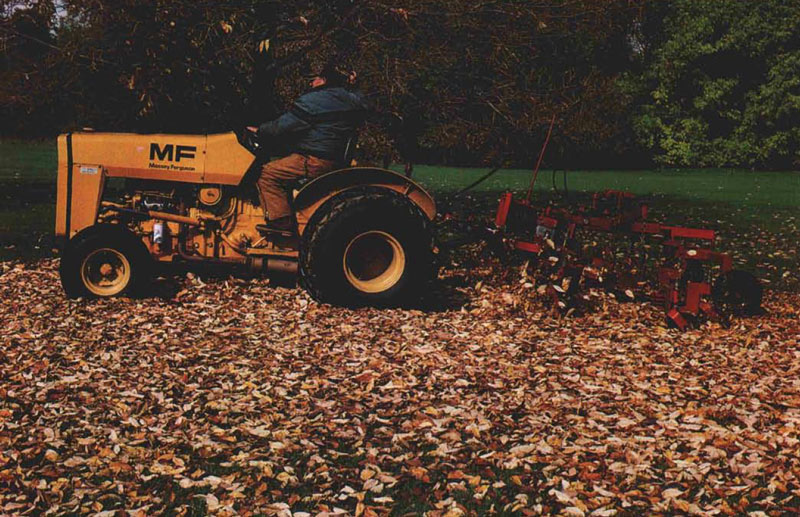
Mulching leaves with an articulator at Walnut Hills Country Club in East Lansing, Mich. Photo courtesy of Thomas Nikolai and Paul Rieke
In addition, we’ve seen few differences beneath the surface attributed to mulching leaves. Soil samples collected in the fall of 1993 indicated no statistical differences in thatch, pH, or soil tests for phosphorus, potassium, calcium and magnesium. There was a small 1995 increase in organic matter in the thatch of plots treated with maple leaves. Oak leaves gave no detrimental results, although there were fewer positive effects than with maple leaves.
Leaf mulch for turfgrass: Techniques and testimonials
Tom Gray, CGCS, superintendent at Franklin Hills Country Club in Franklin, Mich., started mulching leaves into the rough eight years ago. In 1997, Golf Digest ranked Franklin Hills the eighth “Best Conditioned” golf course in the United States.
“We had five vacuums filling 23 dumpsters and were hauling them to a landfill at a cost of $8,750 back in 1989,” Gray recalls. Since then, Franklin Hills has gone from one mulching mower to four and has sold all five of the vacuums.
What’s Gray’s leaf-mulching technique? “We blow the leaves off the tees, greens and fairways into windrows,” he says, “and use up-front rotaries to which we have added a 1/2-inch mesh screen on the discharge opening. This allows the leaves to be mulched to the particle size of a 1/2-inch chip.”
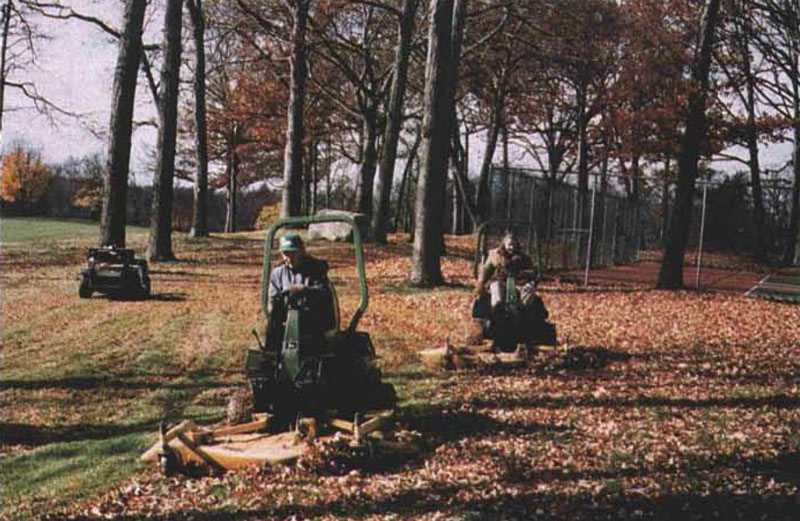
Crew members mulch leaves into the rough at Franklin Hills Country Club in Franklin, Mich. Photo courtesy of Thomas Nikolai and Paul Rieke
Franklin Hills has many trees, and sometimes deep piles of leaves accumulate. When this happens, Gray’s crew manually rakes the mulched leaves and incorporates the litter into flower beds. He reports that his small fall crew is able to keep up with the leaves and keep the membership happy with the condition of the golf course during the fall season.
Kurt Thummell, CGCS, superintendent at Walnut Hills Country Club in East Lansing, Mich., annually hosts the Oldsmobile Classic, an LPGA-sponsored event. “Until a few years ago,” Thummell says, “our method of removing tree leaves was to use blowers, vacuums and rotary mowers. Many hours were spent hauling and piling leaves at the north end of the club’s property.”
But a new maintenance facility was built on that site several years ago, and without the land to stockpile the leaves, finding a new way to dispose of them became necessary. Thummell now mulches nearly 100% of the course’s leaves. He uses small blowers on the greens, tees and bunkers and larger blowers on the surrounds and fairways. He mulches the leaves in the rough with out-front rotary mowers and two pull-type “articulator” rotary mowers.
According to Thummell, “The most effective way to mulch leaves is on sunny days — however, damp weather does not stop us from mulching. We try to avoid mulching in the same area too often. It’s best not to smother the turf with mulched leaves.”
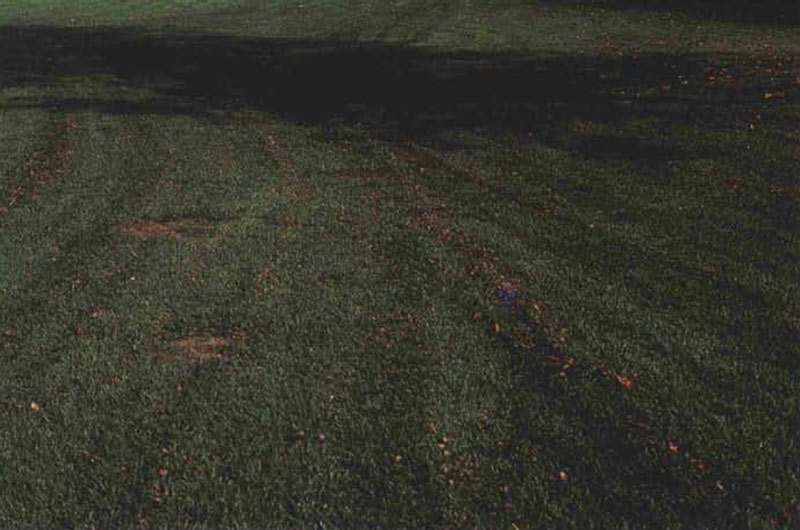
The results of an articulator’s leaf mulching at Walnut Hills Country Club. Photo courtesy of Thomas Nikolai and Paul Rieke
Thummell observes (and our research indicates) that “mulched leaves tend to break down rapidly, usually in a matter of a few weeks.”
When comparing his current practices with collection practices of the past, Thummell is pleased. “We feel that we have extended the golf season by providing a golf course (on which) golfers lose very few balls to accumulated leaves. By using this method of removing leaves, we’ve reduced the hours spent on leaf removal each fall, which normally runs from late September through November.”
Improvements, further investigation needed
Even with these techniques, tree leaf disposal problems continue. The fact that New Jersey called its disposal of leaf litter to farmland an “emergency disposal/utilization strategy” speaks volumes.
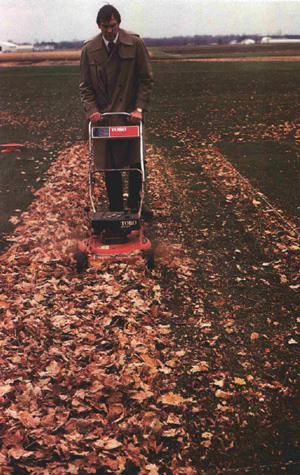
Right: Dressed to the nines, Bruce Branham, Ph.D., initiates Michigan State’s leaf mulch study in 1990. Photo courtesy of Thomas Nikolai and Paul Rieke
It’s apparent that mulching tree leaves into the turfgrass canopy will become a vital part of the disposal solution for golf courses and municipalities. However, techniques still need to be improved, and the industry must manufacture equipment to make the job easier.
The Ultra Mulch blade, made by Browning Enterprises Inc. in London, Ontario, is an example of equipment manufactured to mulch tree leaves. However, the blade isn’t ready for commercial equipment. Last fall at Michigan State, we mulched leaves at a rate of 400 pounds of dry leaves per 1,000 square feet (18 inches high) into a turfgrass plot. The grass plot looked fine this spring.
Research still needs to address many questions regarding leaf mulching into an existing turfgrass canopy. What’s the highest rate of leaves that can be mulched into a turfgrass stand? The answer likely depends upon the equipment you use, the height of cut and the amount of sunlight the area receives. It’s vital to have green grass leaves exposed to the sun after the tree leaves have been mulched. If they aren’t, the plants will become matted and die.
Results from the oak and maple study indicate that different tree leaf species give different responses. Will we find that some species are detrimental to the turfgrass? As we continue to investigate this issue, it seems clear that using turf to accept mulched leaves will provide an economical solution and may convert a maintenance problem into a recoverable resource.
Acknowledgment
Appreciation is expressed to the Michigan Turfgrass Foundation for financial support of this project.
Literature cited
- Heckman, J.R., and D. Kluchinski. 1996. Chemical composition of municipal leaf waste and hand-collected urban leaf litter. Journal of Environmental Quality 25:355-362.
- Steuteville, R. 1995. The state of garbage in America. BioCycle 34:54-63.
Thomas Nikolai is a research assistant in the Department of Crop and Soil Sciences at Michigan State University in East Lansing, Mich. Paul Rieke is a professor in the department.